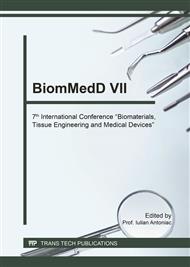[1]
I. M. Chen, S. J. Phee, Z. Luo, C. K. Lim, Personalized biomedical devices & systems for healthcare applications, Frontiers of Mechanical Engineering, 6(1), 3-12, (2011).
Google Scholar
[2]
D. Pisla, H. Bleuler, A. Rodić, C. Vaida, A. Pisla (Eds. ), New Trends in Medical and Service Robots, Theory and Integrated Applications, Mechanisms and Machine Science, Springer, (2014).
DOI: 10.1007/978-3-319-01592-7
Google Scholar
[3]
T. Beck, et al., Knowledge engineering for health: a new discipline required to bridge the ICT gap, between research and healthcare, Hum Mutat., 33(5), 797-802, (2012).
DOI: 10.1002/humu.22066
Google Scholar
[4]
D. Popescu, D. Laptoiu, Rapid prototyping for patient-specific surgical orthopaedics guides: A systematic literature review, Proceedings of the Institution of Mechanical Engineers, Part H: Journal of Engineering in Medicine, 230(6), 495-515, (2016).
DOI: 10.1177/0954411916636919
Google Scholar
[5]
W. Chai, et al. Computer-aided design and custom-made guide in corrective osteotomy for complex femoral deformity. J Huazhong Univ Sci Technolog Med Sci, 33(3), 398–405, (2013).
DOI: 10.1007/s11596-013-1131-x
Google Scholar
[6]
I. Gibson, Additive Manufacturing technology for medical applications. Reverse engineering, software conversion and Rapid Prototyping, Chapter 2, Wiley, 15-29, (2006).
DOI: 10.1002/0470033983.ch1
Google Scholar
[7]
http: /app-poigo. osf-demo. com.
Google Scholar
[8]
D. Popescu, D. Laptoiu, C. Ilie, A. Hadar, R. Barbur, Web-based collaborative platform for personalized orthopaedic applications, Studies in Informatics and Control Journal, 25(4), 517-526, (2016).
DOI: 10.24846/v25i4y201613
Google Scholar
[9]
E. Z. Barsom, M. Graafland, M. P. Schijven, Systematic review on the effectiveness of augmented reality applications in medical training, Surgical Endoscopy, 30(10), 4174–4183, (2016).
DOI: 10.1007/s00464-016-4800-6
Google Scholar
[10]
V. Lahanas, C. Loukas, N. Smailis, E. Georgiou, A novel augmented reality simulator for skills assessment in minimal invasive surgery, Surg Endosc, 29(8), 2224–2234, (2015).
DOI: 10.1007/s00464-014-3930-y
Google Scholar
[11]
I. Cabrilo, A. Sarrafzadeh, P. Bijlenga, B. N. Landis, K. Schaller, Augmented reality-assisted skull base surgery, Neurochirurgie, 6(6), 304-306, (2014).
DOI: 10.1016/j.neuchi.2014.07.001
Google Scholar
[12]
D. Low, C. K. Lee, L. L. Dip, B. T. Ang, I. Ng, Augmented reality neurosurgical planning and navigation for surgical excision of parasagittal, falcine and convexity meningiomas, Br J Neurosurg. 2010, 24(1): 69-74.
DOI: 10.3109/02688690903506093
Google Scholar


